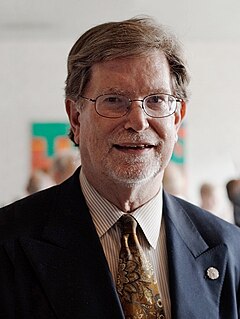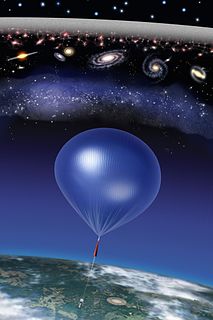
The cosmic microwave background is electromagnetic radiation as a remnant from an early stage of the universe in Big Bang cosmology. In older literature, the CMB is also variously known as cosmic microwave background radiation (CMBR) or "relic radiation". The CMB is a faint cosmic background radiation filling all space that is an important source of data on the early universe because it is the oldest electromagnetic radiation in the universe, dating to the epoch of recombination. With a traditional optical telescope, the space between stars and galaxies is completely dark. However, a sufficiently sensitive radio telescope shows a faint background noise, or glow, almost isotropic, that is not associated with any star, galaxy, or other object. This glow is strongest in the microwave region of the radio spectrum. The accidental discovery of the CMB in 1964 by American radio astronomers Arno Penzias and Robert Wilson was the culmination of work initiated in the 1940s, and earned the discoverers the 1978 Nobel Prize in Physics.

Microwaves are a form of electromagnetic radiation with wavelengths ranging from about one meter to one millimeter; with frequencies between 300 MHz (1 m) and 300 GHz (1 mm). Different sources define different frequency ranges as microwaves; the above broad definition includes both UHF and EHF bands. A more common definition in radio engineering is the range between 1 and 100 GHz. In all cases, microwaves include the entire SHF band at minimum. Frequencies in the microwave range are often referred to by their IEEE radar band designations: S, C, X, Ku, K, or Ka band, or by similar NATO or EU designations.

The Wilkinson Microwave Anisotropy Probe (WMAP), originally known as the Microwave Anisotropy Probe (MAP), was a spacecraft operating from 2001 to 2010 which measured temperature differences across the sky in the cosmic microwave background (CMB) – the radiant heat remaining from the Big Bang. Headed by Professor Charles L. Bennett of Johns Hopkins University, the mission was developed in a joint partnership between the NASA Goddard Space Flight Center and Princeton University. The WMAP spacecraft was launched on June 30, 2001 from Florida. The WMAP mission succeeded the COBE space mission and was the second medium-class (MIDEX) spacecraft in the NASA Explorers program. In 2003, MAP was renamed WMAP in honor of cosmologist David Todd Wilkinson (1935–2002), who had been a member of the mission's science team. After nine years of operations, WMAP was switched off in 2010, following the launch of the more advanced Planck spacecraft by ESA in 2009.

The discovery of cosmic microwave background radiation constitutes a major development in modern physical cosmology. The cosmic background radiation (CMB) was measured by Andrew McKellar in 1941 at an effective temperature of 2.3 K using CN stellar absorption lines observed by W. S. Adams. Theoretical work around 1950 showed that the need for a CMB for consistency with the simplest relativistic universe models. In 1964, US physicist Arno Penzias and radio-astronomer Robert Woodrow Wilson rediscovered the CMB, estimating its temperature as 3.5 K, as they experimented with the Holmdel Horn Antenna. The new measurements were accepted as important evidence for a hot early Universe and as evidence against the rival steady state theory. In 1978, Penzias and Wilson were awarded the Nobel Prize for Physics for their joint measurement.

In physical cosmology, structure formation is the formation of galaxies, galaxy clusters and larger structures from small early density fluctuations. The universe, as is now known from observations of the cosmic microwave background radiation, began in a hot, dense, nearly uniform state approximately 13.8 billion years ago. However, looking in the sky today, we see structures on all scales, from stars and planets to galaxies and, on still larger scales, galaxy clusters and sheet-like structures of galaxies separated by enormous voids containing few galaxies. Structure formation attempts to model how these structures formed by gravitational instability of small early density ripples.

The South Pole Telescope (SPT) is a 10-meter (394 in) diameter telescope located at the Amundsen–Scott South Pole Station, Antarctica. The telescope is designed for observations in the microwave, millimeter-wave, and submillimeter-wave regions of the electromagnetic spectrum, with the particular design goal of measuring the faint, diffuse emission from the cosmic microwave background (CMB). The first major survey with the SPT–designed to find distant, massive, clusters of galaxies through their interaction with the CMB, with the goal of constraining the dark energy equation of state–was completed in October 2011. In early 2012, a new camera (SPTpol) was installed on the SPT with even greater sensitivity and the capability to measure the polarization of incoming light. This camera operated from 2012–2016 and was used to make unprecedentedly deep high-resolution maps of hundreds of square degrees of the Southern sky. In 2017, the third-generation camera SPT-3G was installed on the telescope, providing nearly an order-of-magnitude increase in mapping speed over SPTpol.

COSMOSOMAS is a circular scanning astronomical microwave experiment to investigate the Cosmic Microwave Background anisotropy and diffuse emission from the Galaxy on angular scales from 1 to 5 degrees. It was designed and built by the Instituto de Astrofísica de Canarias (IAC) in Tenerife, Spain, in 1998. Its name comes from "COSMOlogical Structures On Medium Angular Scales" referring to CMB fluctuations. This experiment grew out experience of the previous Tenerife Experiment with the need to go to smaller angular scales with greater sensitivity.

The cosmic neutrino background is the universe's background particle radiation composed of neutrinos. They are sometimes known as relic neutrinos.

The Atacama Cosmology Telescope (ACT) is a six-metre telescope on Cerro Toco in the Atacama Desert in the north of Chile, near the Llano de Chajnantor Observatory. It is designed to make high-resolution, microwave-wavelength surveys of the sky in order to study the cosmic microwave background radiation (CMB). At an altitude of 5,190 metres (17,030 ft), it is one of the highest permanent, ground-based telescopes in the world.

Llano de Chajnantor Observatory is the name for a group of astronomical observatories located at an altitude of over 4,800 m (15,700 ft) in the Atacama Desert of northern Chile. The site is in the Antofagasta Region approximately 50 kilometres (31 mi) east of the town of San Pedro de Atacama. The exceptionally arid climate of the area is inhospitable to humans, but creates an excellent location for millimeter, submillimeter, and mid-infrared astronomy. This is because water vapour absorbs and attenuates submillimetre radiation. Llano de Chajnantor is home to the largest and most expensive astronomical telescope project in the world, the Atacama Large Millimeter Array (ALMA). Llano de Chajnantor and the surrounding area has been designated as the Chajnantor Science Reserve by the government of Chile.

George Fitzgerald Smoot III is an American astrophysicist, cosmologist, Nobel laureate, and one of two contestants to win the US$1 million prize on Are You Smarter than a 5th Grader?. He won the Nobel Prize in Physics in 2006 for his work on the Cosmic Background Explorer with John C. Mather that led to the "discovery of the black body form and anisotropy of the cosmic microwave background radiation".
The Tenerife Experiment was a Cosmic Microwave Background (CMB) experiment built by Jodrell Bank of the University of Manchester and in collaboration with the Instituto de Astrofisica de Canarias (IAC). It was installed and run at the Observatorio del Teide in Tenerife in 1984, and ran with various upgrades and additional experiments until 2000. Contact was made with the Instituto de Astrofísica de Canarias (IAC) which had shown that the Teide Observatory was an ideal site for infra-red observations. An agreement was arrived at and the first radiometer (10 GHz) was installed in 1984 and so was born the Tenerife Experiment.
RELIKT-1 - a Soviet cosmic microwave background anisotropy experiment on board the Prognoz 9 satellite gave upper limits on the large-scale anisotropy. A reanalysis of the data in the later years claimed a confident blackbody form and anisotropy of the cosmic microwave background radiation. Results have been reported in January 1992 at the All-Moscow Astronomy Seminar held at Sternberg Astronomical Institute, and published, for example, in issue 4/1992 of the "Science in USSR" journal and in Soviet Astronomy Letters in May–June 1992. Nevertheless, the Nobel Prize in Physics for 2006 was awarded to a team of American scientists, who announced the fact on April 23, 1992 based on data taken by the COBE spacecraft.

The Degree Angular Scale Interferometer (DASI) was a telescope installed at the U.S. National Science Foundation's Amundsen–Scott South Pole Station in Antarctica. It was a 13-element interferometer operating between 26 and 36 GHz in ten bands. The instrument is similar in design to the Cosmic Background Imager (CBI) and the Very Small Array (VSA). In 2001 The DASI team announced the most detailed measurements of the temperature, or power spectrum of the Cosmic microwave background (CMB). These results contained the first detection of the 2nd and 3rd acoustic peaks in the CMB, which were important evidence for inflation theory. This announcement was done in conjunction with the BOOMERanG and MAXIMA experiment. In 2002 the team reported the first detection of polarization anisotropies in the CMB.
Spider is a balloon-borne experiment designed to search for primordial gravitational waves imprinted on the cosmic microwave background (CMB). Measuring the strength of this signal puts limits on inflationary theory.

In modern cosmological theory, diffusion damping, also called photon diffusion damping, is a physical process which reduced density inequalities (anisotropies) in the early universe, making the universe itself and the cosmic microwave background radiation (CMB) more uniform. Around 300,000 years after the Big Bang, during the epoch of recombination, diffusing photons travelled from hot regions of space to cold ones, equalising the temperatures of these regions. This effect is responsible, along with baryon acoustic oscillations, the Doppler effect, and the effects of gravity on electromagnetic radiation, for the eventual formation of galaxies and galaxy clusters, these being the dominant large scale structures which are observed in the universe. It is a damping by diffusion, not of diffusion.

Absolute Radiometer for Cosmology, Astrophysics, and Diffuse Emission (ARCADE) is a program which utilizes high-altitude balloon instrument package intended to measure the heating of the universe by the first stars and galaxies after the big bang and search for the signal of relic decay or annihilation. In July 2006 a strong residual radio source was found using the radiometer, approximately six times what is predicted by theory. This phenomenon is known as "space roar" and remains an unsolved problem in astrophysics.

Cosmic background radiation is electromagnetic radiation from the Big Bang. The origin of this radiation depends on the region of the spectrum that is observed. One component is the cosmic microwave background. This component is redshifted photons that have freely streamed from an epoch when the Universe became transparent for the first time to radiation. Its discovery and detailed observations of its properties are considered one of the major confirmations of the Big Bang. The discovery of the cosmic background radiation suggests that the early universe was dominated by a radiation field, a field of extremely high temperature and pressure.

In cosmology, recombination refers to the epoch at which charged electrons and protons first became bound to form electrically neutral hydrogen atoms. Recombination occurred about 378,000 years after the Big Bang. The word "recombination" is misleading, since the big bang theory doesn't posit that protons and electrons had been combined before, but the name exists for historical reasons since it was named before the Big Bang hypothesis became the primary theory of the creation of the universe.

POLARBEAR is a cosmic microwave background polarization experiment located in the Atacama Desert of northern Chile in the Antofagasta Region. The POLARBEAR experiment is mounted on the Huan Tran Telescope (HTT) at the James Ax Observatory in the Chajnantor Science Reserve. The HTT is located near the Atacama Cosmology Telescope on the slopes of Cerro Toco at an altitude of nearly 5,200 m (17,100 ft).












